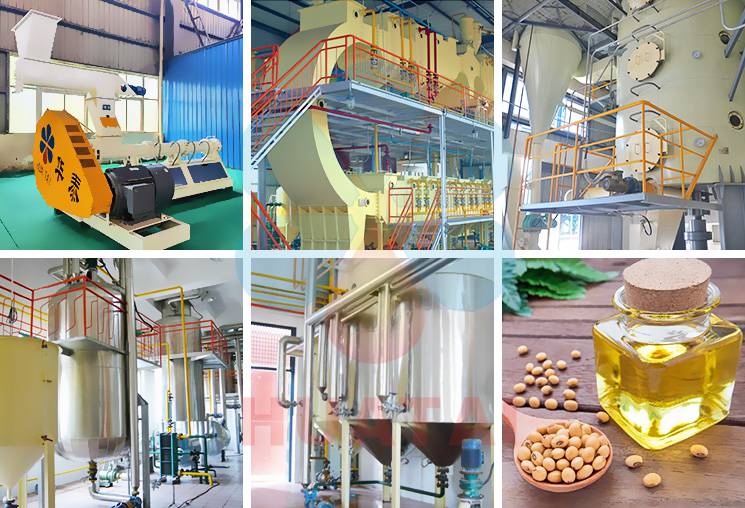China's largest edible oil processming machine manufacturer
China's largest edible oil processming machine manufacturer
Soybean oil is the world’s largest production edible oil, Henan Huatai soybean oil extraction machinery has four workshops: soybean pretreatment, soybean oil extraction plant, soybean crude oil refining plant, and soybean refined oil filling.
Henan Huatai soybean oil extraction process: Cleaning – Crushing – Softening -Soybean Rolling- Soybean oil extraction – Soybean oil refining – Filling.

Soybean oil pretreatment and pressing machine can highly increase oil yield, and it can be applied to other oil seeds as well, such as peanut, rice bran, sunflower seed, and rapeseed and so on. For different oil seeds, the pretreatment and pressing technology is various. The soybean oil pretreatment and pressing machine is efficient and energy-saving.
1.Soybeans cleaning
The soybean cleaning process, that is the screening and stone removal process. Cleaning is very important for the oil pre-treatment process. It is necessary to use a cleaning screen to remove large impurities, a magnetic separator to remove metal impurities, and a destoner to remove hard impurities such as mud in the material. Equipped with a suction air net system, it can effectively control the dust of raw materials and ensure the cleanliness of soybean raw materials.
2.Crushing process
After the soybean are crushed by the crusher, the surface area increases, which facilitates the transfer of temperature and moisture during steaming and frying, and improves the steaming and frying effect.
3.Soybean Softening
The function of conditioning is to adjust the moisture and temperature of the soybean so that they have a certain degree of plasticity, making it easier to separate the oil from the embryos during pressing.
4.Soybean Rolling
Soybean rolling is the process of using the mechanical function to roll the soybean from the granular to flake.

Pressed soybean cake→Solvent extraction system→D.T.D.C system→Condenser system→Recovery system→Crude soybean oil
The soybean oil solvent extraction plant is an important part of soybean oil production line, which is designed to extract oil directly from pressed soybean cake. After soybean oil solvent extraction plant, the residual oil rate in soybean cake is less than 1%.
The pretreated soybean flakes are sent to the soybean oil solvent extraction plant. The plant uses a kind of solvent (normal hexane) to absorb the oil from soybean, and then the machines separate the solvent from soybean crude oil. The solvent is used for recycling and soybean crude oil is refined by oil refinery plant.

In addition to some mechanical impurities, crude soybean oil also contains impurities such as phospholipids, proteins, free fatty acids, pigments and odor substances. These impurities are the main factors leading to rancidity, oxidation and deterioration of edible oil, and also affect the color, flavor and flavor of the oil. Food safety. Simple filtration cannot remove them. Oil refining equipment needs to be used to refine the oil to remove these impurities and improve the quality of the oil. Soybean oil refining needs to go through major processes such as degumming, deacidification, dehydration, decolorization, deodorization. It is commonly known as the “six removal” process. The edible oil that has passed the “six removal” process will obtain first-level extracted soybean oil after passing the laboratory test.
1. Degumming section
Purpose: To remove peptidic impurities in soybean oil.
Operation process: Heat the crude soybean oil first, then add hot water to the oil and start stirring. Peptide-soluble impurities are hydrophilic and will agglomerate into clusters when exposed to water. After settling, the peptide-soluble impurities can be separated from soybean oil.
2.Deacidification section
Purpose: to remove free fatty acids from soybean oil.
Operation process: The operation process of the deacidification section is related to the deacidification method. There are two methods of deacidification: chemical deacidification and physical deacidification. Chemical deacidification is carried out in an alkali kettle. During chemical deacidification, alkali solution is added to soybean oil to neutralize it with free fatty acids. After the neutralization reaction, the by-product soapstock will be produced. After sedimentation, the soapstock will be discharged from the oil to complete the chemical deacidification process. Physical deacidification is carried out in the upper part of the deodorization tower. During physical deacidification, high-temperature water vapor is introduced into the deodorization tower, and free fatty acids are separated from the oil using the principle of distillation to complete the deacidification process.
3.Decolorization section
Purpose: To remove pigments from soybean oil.
Operation process: The temperature required in the decolorization section is generally around 105°C. Before decolorizing, a vacuum should be maintained in the decolorizing equipment. Then add white clay to the oil, and use the adsorption properties of the white clay to remove the pigment in the oil. In addition to pigments, white clay can also absorb other particulate impurities. The decolorized soybean oil must be filtered through a leaf filter to discharge the waste clay, thereby completing the decolorization section.
4. Deodorization section
Purpose: to remove odor substances in soybean oil.
Operation process: The temperature required in the deodorization section is generally around 260°C, so the vacuum state must be maintained before deodorization. During deodorization, direct steam should be passed into the deodorization equipment, and the difference in volatility of grease and odor substances should be used to remove odor substances in the oil.
The deodorization part of the soybean oil refining equipment is made of stainless steel, which can prevent the deodorization equipment from being damaged due to high temperature and high vacuum conditions, and does not affect the deodorization effect of soybean oil.

Huatai Oil Machinery, was founded in 1988, which is a large-scale oil project manufacturing enterprise.
We use cookies to improve your experience on our site. By using our site, you consent to cookies.
Manage your cookie preferences below:
Essential cookies enable basic functions and are necessary for the proper function of the website.